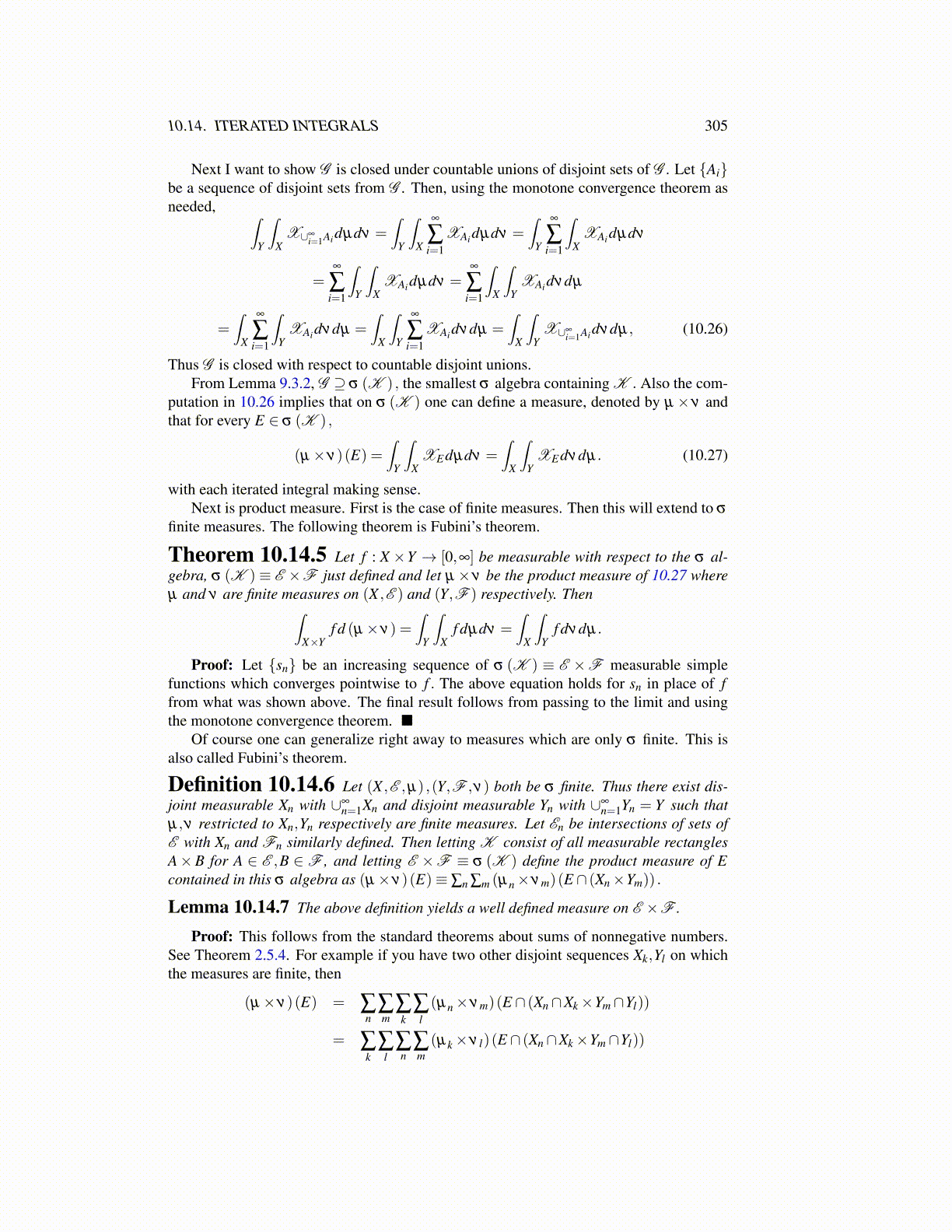
10.14. ITERATED INTEGRALS 305
Next I want to show G is closed under countable unions of disjoint sets of G . Let {Ai}be a sequence of disjoint sets from G . Then, using the monotone convergence theorem asneeded, ∫
Y
∫X
X∪∞i=1Aidµdν =
∫Y
∫X
∞
∑i=1
XAidµdν =∫
Y
∞
∑i=1
∫X
XAidµdν
=∞
∑i=1
∫Y
∫X
XAidµdν =∞
∑i=1
∫X
∫Y
XAidνdµ
=∫
X
∞
∑i=1
∫Y
XAidνdµ =∫
X
∫Y
∞
∑i=1
XAidνdµ =∫
X
∫Y
X∪∞i=1Aidνdµ, (10.26)
Thus G is closed with respect to countable disjoint unions.From Lemma 9.3.2, G ⊇ σ (K ) , the smallest σ algebra containing K . Also the com-
putation in 10.26 implies that on σ (K ) one can define a measure, denoted by µ ×ν andthat for every E ∈ σ (K ) ,
(µ×ν)(E) =∫
Y
∫X
XEdµdν =∫
X
∫Y
XEdνdµ. (10.27)
with each iterated integral making sense.Next is product measure. First is the case of finite measures. Then this will extend to σ
finite measures. The following theorem is Fubini’s theorem.
Theorem 10.14.5 Let f : X ×Y → [0,∞] be measurable with respect to the σ al-gebra, σ (K )≡ E ×F just defined and let µ×ν be the product measure of 10.27 whereµ and ν are finite measures on (X ,E ) and (Y,F ) respectively. Then∫
X×Yf d (µ×ν) =
∫Y
∫X
f dµdν =∫
X
∫Y
f dνdµ.
Proof: Let {sn} be an increasing sequence of σ (K ) ≡ E ×F measurable simplefunctions which converges pointwise to f . The above equation holds for sn in place of ffrom what was shown above. The final result follows from passing to the limit and usingthe monotone convergence theorem. ■
Of course one can generalize right away to measures which are only σ finite. This isalso called Fubini’s theorem.
Definition 10.14.6 Let (X ,E ,µ) ,(Y,F ,ν) both be σ finite. Thus there exist dis-joint measurable Xn with ∪∞
n=1Xn and disjoint measurable Yn with ∪∞n=1Yn = Y such that
µ,ν restricted to Xn,Yn respectively are finite measures. Let En be intersections of sets ofE with Xn and Fn similarly defined. Then letting K consist of all measurable rectanglesA×B for A ∈ E ,B ∈ F , and letting E ×F ≡ σ (K ) define the product measure of Econtained in this σ algebra as (µ×ν)(E)≡ ∑n ∑m (µn×νm)(E ∩ (Xn×Ym)) .
Lemma 10.14.7 The above definition yields a well defined measure on E ×F .
Proof: This follows from the standard theorems about sums of nonnegative numbers.See Theorem 2.5.4. For example if you have two other disjoint sequences Xk,Yl on whichthe measures are finite, then
(µ×ν)(E) = ∑n
∑m
∑k
∑l(µn×νm)(E ∩ (Xn∩Xk×Ym∩Yl))
= ∑k
∑l
∑n
∑m(µk×ν l)(E ∩ (Xn∩Xk×Ym∩Yl))